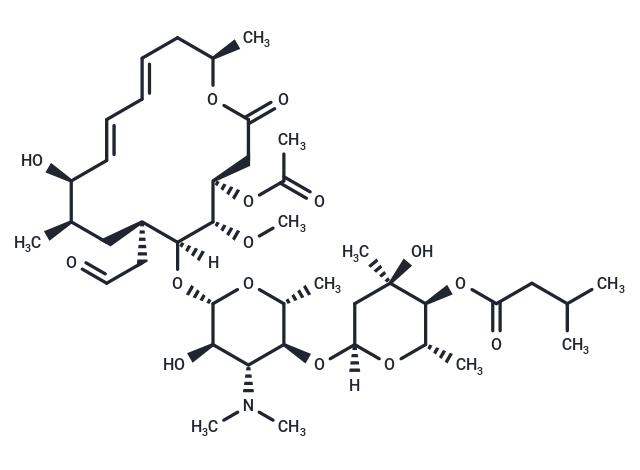Shopping Cart
- Remove All
 Your shopping cart is currently empty
Your shopping cart is currently empty

Josamycin (EN-141) is a macrolide antibiotic with antimicrobial activity, characterized by a ribosomal dissociation constant (Kd) of 5.5 nM.

| Pack Size | Price | Availability | Quantity |
|---|---|---|---|
| 25 mg | $43 | In Stock | |
| 50 mg | $68 | In Stock | |
| 100 mg | $117 | In Stock | |
| 500 mg | $283 | In Stock | |
| 1 mL x 10 mM (in DMSO) | $48 | In Stock |
| Description | Josamycin (EN-141) is a macrolide antibiotic with antimicrobial activity, characterized by a ribosomal dissociation constant (Kd) of 5.5 nM. |
| Targets&IC50 | Ribosome:5.5 nM (Kd) |
| In vitro | Josamycin significantly attenuated NO production elicited by P. intermedia LPS as well as induction of iNOS protein and mRNA in RAW264.7 cells. While the release of IL-1β from cells stimulated by LPS was suppressed in the presence of josamycin, josamycin failed to reduce the degree of IL-1β mRNA expression. Josamycin did not reduce the stability of IL-1β mRNA induced by P. intermedia LPS, at the same time josamycin also failed to suppress the LPS-induced intracellular IL-1β expression. Josamycin augmented HO-1 induction in cells exposed to P. intermedia LPS, and SnPP, an inhibitor of HO-1 activity, reversed the suppressive impact of josamycin upon NO generation induced by LPS. Josamycin diminished NF-κB transcriptional activity induced by P. intermedia LPS. Further, josamycin enhanced SOCS1 mRNA level in cells activated with LPS[1]. |
| In vivo | Josamycin (0.1%) was topically administered to NC/Nga mice with AD-like skin lesions induced by 2, 4, 6-trinitrochlorobenzene (TNCB). The therapeutic effects of josamycin were assessed by measurement of the skin severity scores, histological changes in the lesioned skin, serum levels of total IgE, and expression of interferon (IFN)-γ and interleukin (IL)-4 in lymph nodes and skin lesions[2]. |
| Cell Research | LPS was purified by employing phenol-water extraction protocol. Culture supernatants were analyzed for nitric oxide (NO) and interleukin (IL)-1β. Real-time PCR and immunoblotting were conducted to quantify mRNA and protein expression, respectively. The expression levels of IL-1β were analyzed by confocal laser scanning microscopy. NF-κB-dependent SEAP levels were estimated by reporter assay[1]. |
| Animal Research | Topical treatment with josamycin significantly suppressed the increase in the skin severity score in NC/Nga mice. This suppressive effect was equal to that of betamethasone, and was associated with a decrease in the density of cellular infiltration into the dermis, the mast cell count in the dermis and the serum IgE level. Furthermore, topical application of josamycin reduced the expression of IFN-γ and IL-4 in auricular lymph node cells and the skin lesions[2]. |
| Alias | EN-141 |
| Molecular Weight | 827.99 |
| Formula | C42H69NO15 |
| Cas No. | 16846-24-5 |
| Smiles | [H][C@@]1(C[C@@](C)(O)[C@@H](OC(=O)CC(C)C)[C@H](C)O1)O[C@@H]1[C@@H](C)O[C@@H](O[C@@]2([H])[C@@H](CC=O)C[C@@H](C)[C@@H](O)\C=C\C=C\C[C@@H](C)OC(=O)C[C@@H](OC(C)=O)[C@@H]2OC)[C@H](O)[C@H]1N(C)C |
| Relative Density. | 1.1547 g/cm3 (Estimated) |
| Storage | Powder: -20°C for 3 years | In solvent: -80°C for 1 year | Shipping with blue ice. | |||||||||||||||||||||||||
| Solubility Information | DMSO: 35 mg/mL (42.27 mM), Sonication is recommended. | |||||||||||||||||||||||||
Solution Preparation Table | ||||||||||||||||||||||||||
DMSO
| ||||||||||||||||||||||||||

Copyright © 2015-2024 TargetMol Chemicals Inc. All Rights Reserved.